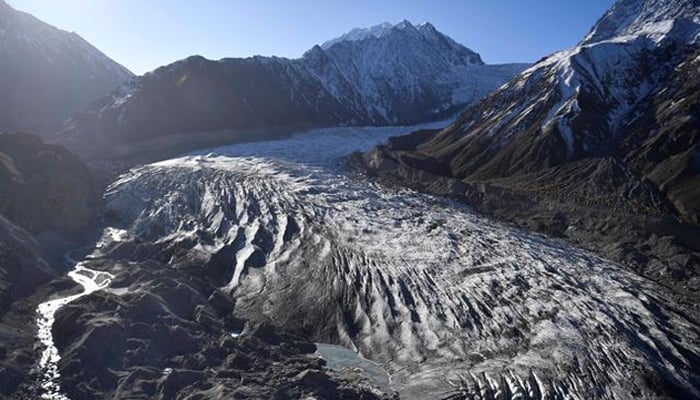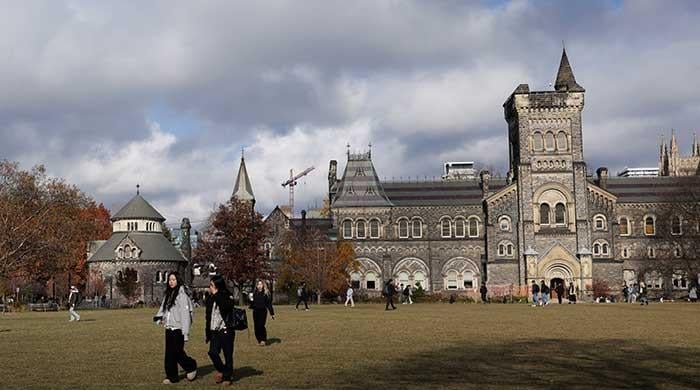Over 7m people in South Asia at risk as climate emergency swells glacier lakes
With a count of almost 7,000 glaciers, Pakistan has more glaciers than any other place on the Earth after the polar regions
September 01, 2020

PARIS/KARACHI: Climate emergency has fuelled a sharp and concerning rise in the volume of glacier lakes, according to a new study based on satellite data, as ice floes around the world continue to melt, posing threat to over seven million people in South Asia, including Pakistan.
Published Monday in Nature Climate Change, the study indicates that the the volume of glacier lakes has jumped 50% over the past 30 years, with its lead author Dan Shugar — a geomorphologist and associate professor at the University of Calgary — saying the findings help estimate how much water was being stored in lakes.
"We have known that not all meltwater is making it into the oceans immediately," Shugar said. "But until now there were no data to estimate how much was being stored in lakes or groundwater."
Unlike normal ones, glacier lakes are unstable because they are often dammed by ice or sediment composed of loose rock and debris. When accumulating water bursts through these accidental barriers, massive flooding can occur downstream — formally known as glacial lake outburst floods (GLOF).
GLOFs have been responsible for thousands of deaths in the last century, as well as the destruction of villages, infrastructure, and livestock, according to the study.
GLOF projects in Pakistan
The most recent GLOF incident was recorded in May 2020, when the water outburst washed through Hunza Valley. Prior to that, another one occurred back in July 2019, when the infrastructure and crops in Chitral's Golain Valley sustained severe damage, indicating how climate emergency has already started wreaking havoc.
With a count of almost 7,000 glaciers, Pakistan has more glaciers than any other place on the Earth after the polar regions.
Interestingly, the UN Development Programme (UNDP) had estimated in January that over 3,000 glacial lakes have formed in the Hindukush-Himalayan region, with 33 posing an imminent threat that could impact as many as seven million people.
Related: Call for urgent steps to tackle effects of climate change in Pakistan
A study published by the Royal Meteorological Society in January 2020, for example, indicated that the Darkut glacial lake extent "has increased from 0.045 to 0.154 km² in the last two decades", or more than 240%. Its authors had warned of "a potential threat of a GLOF to Darkut village" in case the moraines barrier and stream bed erodes during intensive melting of the glacier.
Separately, the UNDP is carrying out another project called 'Scaling-up of GLOF risk reduction in Northern Pakistan (GLOF-II)', which aims to "empower communities to identify and manage risks" from this threat, "strengthen public services", and "improve community preparedness and disaster response".
Aimed for completion in December 2021, the $20.83-million GLOF-II project notes how 3,044 glacial lakes have developed in Gilgit-Baltistan (GB) and Khyber Pakhtunkhwa (KP), making more than 7.1 million people — almost a quarter of whom are below the poverty line — vulnerable.
35% rise in sea level from glacier melting
Since preindustrial times, Earth's average surface temperature has risen 1°C and high mountain regions around the world warmed at twice that pace, accelerating the glacier melt. In light of this, the new findings will also improve the accuracy of sea-level rise estimates through better understanding of how — and how quickly — water shed by glaciers makes it to the sea.
The latest study — based on 250,000 scenes from NASA's Landsat satellite missions — estimates current glacial lake volume at more than 150 cubic kilometres (37 cubic miles), equivalent to one-third the volume of Lake Erie in the United States or twice the volume of Lake Geneva.
Between 1994 and 2017, the world's glaciers — especially in high-mountain regions — shed about 6.5 trillion tonnes in mass, according to earlier research.
"In the past 100 years, 35% of global sea-level rises came from glacier melting," Anders Levermann, a climate professor at the Potsdam Institute for Climate Change Impact, told AFP. The other main sources of sea level rise are ice sheets and the expansion of ocean water as it warms.
A decade ago, it would have not been possible to process and analyse that volume of data, said Shugar. Now, the findings will help scientists and governments identify potential hazards to communities downstream of these often unstable lakes.









